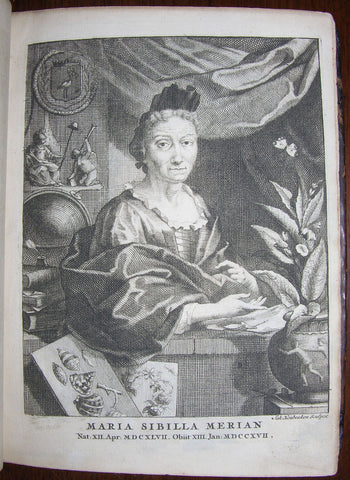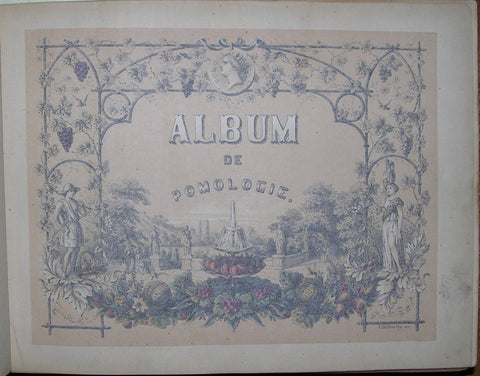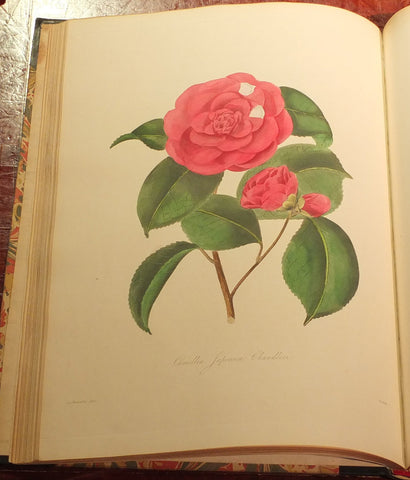Maria Sibylla Merian (1647-1717) Dorothea Maria Henriette (1678-1745), Erucarum ortus, alimentum et paradoxa metamorphosis
Maria Sibylla Merian (1647-1717), Johanna Helena Merian (1668-1723)
Dissertatio de generatione et metamorphoibus insectorum Surinamensium
Amsterdam: Johannes Oosterwijk, [1718]
MERIAN, Maria Sybilla (1647-1717). Erucarum ortus, alimentum et paradoxa metamorphosis, in qua origo, pabulum, transformatio, nec non tempus, locus & proprietates erucarum, vermium, papilionum, phalaenarum, muscarum, aliorumque hujusmodi exsanguium animalculorum exhibentur in favorem, atque insectorum, herbarum, florum, & plantarum amatorum, tumetiam pictorum, limbolariorum, aliorumque commodum exacte inquisita, ad vivum delineata, typis excusa, compendioseque descripta per Mariam Sibillam Merian. Amsterdam: Johannes Oosterwijk,...per dictam Mariam Sibillam Merian unquam Composita, Prostant, [1719].
3 parts in one volume, bound as Part II, Part III, and Part I. 4to., plates in half-sheets (7 4/8 x 5 4/8 inches). Hand-coloured engraved allegorical frontispiece by Simon Schijnvoet dated 1717 (supplied), engraved armorial vignette headpiece opening dedication, engraved portrait of Merian, followed by 3 engraved sectional title-pages (Part II, Part III, and then Part I) of wreaths with original hand-colour, and without text, 149 (of 150) beautiful engraved plates with original hand-colour (some plates misbound, the last plate in facsimile, some light browning, pale marginal waterstaining to the last 14 leaves). 19th-century brown calf (rebacked to style).
Provenance: with the ownership inscription of T. Harrison, dated 1820 on the front free endpaper; the slightly later ownership inscription of J. Gough beneath; the engraved armorial bookplate of Harry Harnold Arnbarrow on the front paste-down; the bookplate of the Arcadian Library on the front paste-down, their sale 14th November 2007, lot 238.
An attractive copy of the first complete Latin edition of Merian's "Raupenbuch". A translation by Merian’s daughter Dorothea Maria Henriette Merian of the first two parts of "Der Raupen wunderbare Verwandelung und sonderbare Blumen-Nahrung" -"Of the marvelous transformation and singular flower-food of caterpillars", published in German in Nuremberg in 1679 and 1683, each volume with fifty plates engraved and etched by Merian to accompany her descriptions of insects, primarily moths, butterflies, and their larvae. A third part was first published in Dutch in 1717, after Merian's death, and edited with additions by Dorothea.
Merian's study of caterpillars and butterflies and the plants that nourish them was "the work of her lifetime" (Wettengl, p.54), in that the preparation and publication of several parts and editions of her "Raupenbuch", spanned her entire career. Merian herself in her "Studienbuch", now housed in St. Petersburg, Russia, records that she was raising silkworms and other insects by the time she was 13 in 1660. At the end of her life, she was immersed in preparing the third part of the "Raupenbuch" for publication, and one of the pre-eminent publisher's of the age.
Daughter of Swiss topographical artist Matthaus Merian, and Johanna Sybilla Heim, Merian had been raised in Germany by Heim and her stepfather, the artist Jacob Marrel. Her first and rarest work, the "Blumenbuch" was issued in 3 parts, each consisting of 12 plates, in 1675, 1677 and 1680, respectively. In 1680 a composite issue appeared of all three parts, newly entitled "Neues Blumenbuch", with two leaves of text containing an introduction and a register of plant names. While in Germany she married the Nuremberg painter Johann Andreas Graff, and published the first two parts of the "Raupenbuch" .
In 1699, following Merian's separation from her husband, Merian travelled with her daughters to Dutch Surinam: "expressly to study and record the insect life of the tropics... this voyage was not only unusual for a woman in her position, it was unprecedented for any European naturalist to venture such an independently financed and organized expedition. In Surinam she worked for almost two years collecting, observing and painting over ninety species of animals and sixty or more species of plants" (Etheridge, page 2).
Merian returned from Surinam in 1701, and in late 1704, she published her magnum opus, "Metamorphosis insectorum surinamensium" in Dutch. In 1713 she published a revised Dutch edition in her own more succinct translation, of the "Raupenbuch", as "Der Rupsen", with part III delayed by her poor health, appearing posthumously in 1717. As early as 1705, Merian had projected publication of the work in Latin as well as Dutch, but this first Latin edition did not appear until after her death, under the imprint of the Amsterdam publisher Johannes Oosterwijck, who had acquired all the plates and texts of Merian's works from Dorothea at the time of her move to St. Petersburg in the autumn of 1717.
Merian's work on caterpillars is a product of her remarkable synthesis of scientific and artistic genius. In her introduction to the 1679 edition of the first part, she stated that preparation of the work had taken her five years: "the work of these years consisted of both scientific and artistic activity: Merian collected and raised insects, fed them with their host plants, observed them, described and drew their metamorphoses from egg to caterpillar and from pupa to butterfly imago. She then compiled her individual observations and studies in pictorial compositions" (Wettengle, pg. 103).
The exquisite plates show Lepidoptera in the various states of the metamorphosis, depicted simultaneously with the flowering plants upon which they feed (4 plates show five stages of a moth or butterfly alone, with no plant or only portions of plants). In incorporating their plant food into portraits of the insects, and showing them simultaneously, in their various states of development, her book broke radically with tradition. "In order to present the process of metamorphosis in the most vivid manner possible she merged the flower painting with the insect piece. To this end she simply reversed the conventional roles of central motif and secondary elements, so that the plants that now occupied central positions in the compositions were employed primarily in support of what had formerly been subordinate to them" (op. cit., p.59). Brunet IV, 1650; Nissen BBI 1342; Blunt 127; Landwehr, Studies in Dutch Books wth Coloured Plates, 135; Wettengle, ed. Maria Sibylla Merian... artist and naturalist [Frankfurt, Hatje, 1998], no. 155, and pp. 53-65.
We Also Recommend















